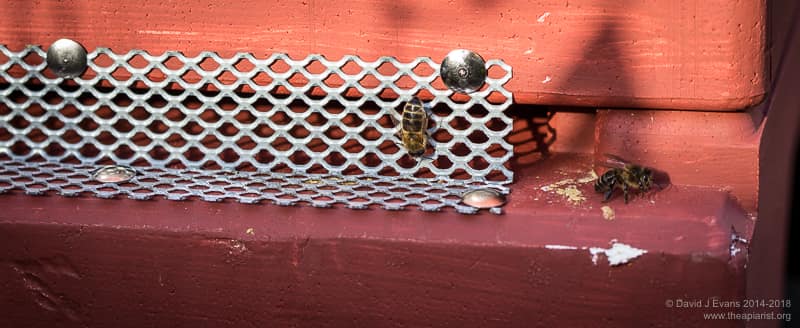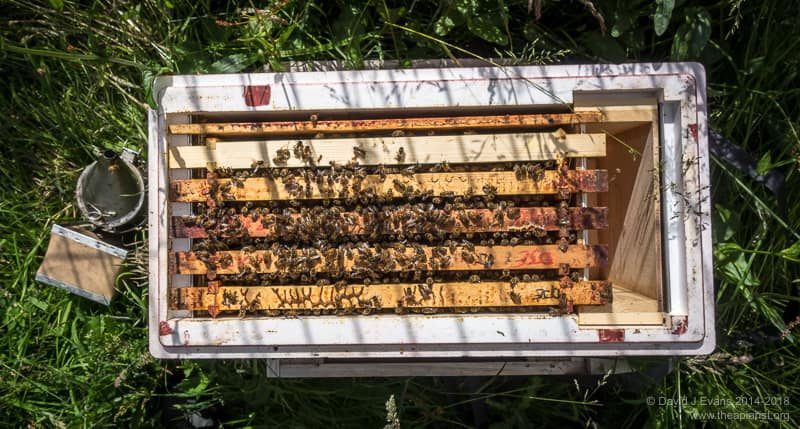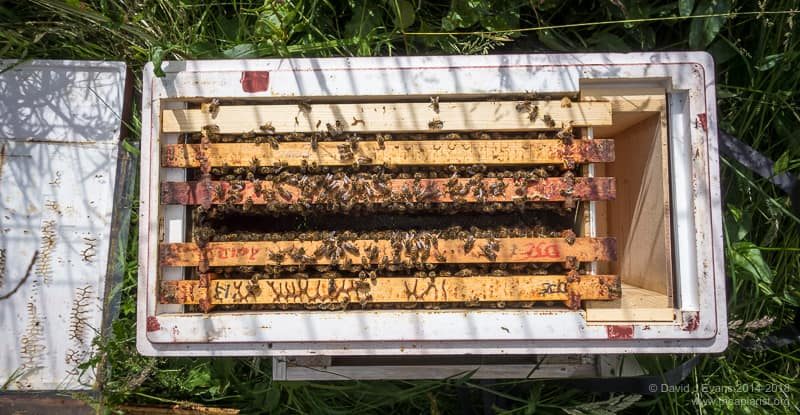Everynuc elbow room
Of the polystyrene nucleus hives (polynucs) I’ve seen, owned or butchered, the Everynuc sold by Thorne’s is the one I prefer. They have a separate OMF floor and Varroa tray, are easy to paint and are made from dense, robust and thick (i.e. well-insulating) polystyrene. The entrance is a gaping maw, but that is easily fixed with some wire mesh pinned in place. The beespace is also an issue due to the compromises made to accommodate both long-lugged National and short-lugged Langstroth frames, but again this can be fixed easily and cheaply (though it’s a bit irritating having to ‘fix’ a box that costs almost £50 🙁 ).
Polynucs for overwintering
Colonies overwintered in these boxes did very well and were generally at least as good, and often better, than my colonies in cedar hives†. Although I’ve also purchased a few of the Miller-type feeders it’s actually easier to prise up one end of the crownboard and simply drop fondant – or pour syrup – into the integral feeder in the brood box. Checking the remaining fondant/syrup levels takes seconds through the clear flexible crownboard and barely disturbs the colony at all.
Polynucs for queen mating
Due to work commitments I haven’t had time this season to deal with high-maintenance mini-nucs for queen mating, so have been exclusively using these Everynucs. With the vagaries of the weather in my part of the world it’s good not to have to keep checking them for stores during cold, wet periods. It’s also great to work with full-sized brood frames that allow the laying pattern of the queen to be determined easily. I usually raise a couple of batches of queens in a season and this means I’m going in and out of a dozen or so of these boxes regularly, making them up, priming them with a sealed queen cell, inspecting them for a mated queen etc. I usually start them off as 3 frame nucs, dummied down, to save resources, allowing them to expand with successive batches of queens.
Space for five and a bit frames
One of the nice features of these boxes is their internal width which is almost but not quite sufficient for 6 Hoffmann frames. You therefore need to use five frames together with a dummy board to avoid strong colonies building brace comb in the gaps on one or both sides of the outside frames. One advantage of this additional ‘elbow room’ is that these boxes can accommodate slightly fatter brood frames, for example when the bees build up the corners with stores rather than drawing out foundation of the adjacent frame. There’s also ample space to introduce a queen cell or caged queen, check for emergence – or release – in a day or two and then gently push the frames back together again.
Even better, by removing the dummy board there’s enough space to work from one side of the box to the other without first removing, and leaving aside, a frame to make space. The frames do need to be removed gently and slowly to avoid rolling bees (but you do this anyway of course). However, since I’m generally looking for the recently mated and laying queen ‘slow and steady’ is a definite advantage. In the image below you can see the space available, even when four of the frames are reasonably heavily propilised.
To make frame manipulation easier it’s worth adding a frame runner on the inside of the feed compartment (it’s the white strip just visible in the photo above) as described previously. Without this the bees tend to stick the frames to the coarse wooden lip of the feeder with propolis, thereby making it more difficult to gently slide the frames together (or apart).
The brood boxes of these Everynuc’s stack, meaning you can easily unite two nucs into a vertical 10-frame unit using newspaper. The vertical beespace is wrong (the boxes are appreciably deeper than a National frame) so the resulting colony should be moved to a standard 10-12 frame brood box before they build extensive brace comb. As the season draws to an end it’s therefore possible to take pairs of boxes, remove the queen from one to requeen another hive, unite the colonies and then – a week or so later – have a good 10-frame colony to prepare for overwintering … or, of course, overwinter them directly in these nucleus hives.
† The only exception were those in the bee shed which were probably 2-3 weeks even further ahead in their development by late March/early April this year.





Join the discussion ...